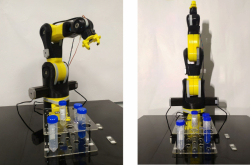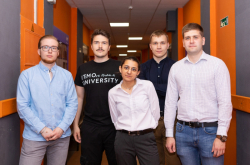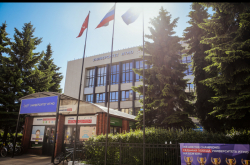What was the seminar like?
This was far from your usual conference. It went on for seven days; the emphasis, of course, was on the Nobel Prize winners’ speeches on the second-to-last day, but we’d had a lot of other scientific events. The format was unusual: they combined a poster session with on-stage presentations. The participants would answer questions about their projects in a large hall next to their posters. We were split into teams of six and brought onto the stage over the course of an hour, so we each had ten minutes: five to present our projects and five to answer the audience’s questions. The stage was quite spectacular, as the building we were in actually used to be a circus.
Your presentation topic was “Robot Economics: Next Step in Digital Economy”; tell us more about this project.
I’m working on the IOT-OPEN.EU project as part of the Erasmus+ program; my colleagues from Airalab and I are working on autonomous robotic systems that co-interact through the internet. This is a part of a larger project, AIRA, which is currently in development at ITMO. My part in that project concerns the development of various mock-ups, samples and booths which we use to promote the project. It was necessary to explain to people what Robot Economics is and how it can enhance our everyday life - and so I did. Notably, judging by the questions I was asked, many Europeans see a direct link between robots and AI. Many asked me about the dangers of AI, which I thought was strange, as I was just showing them how agents interact within an economic network. For my part, I asked the audience questions like – “why can’t we call a washing machine a robot?” After all, it has a program, it receives tasks from humans and oversees the whole process; it’s kind of like an AI, but it’s not a robot.

Valery Chernov (second from right) with other participants of Stockholm International Youth Science Seminar
Overall, the topics of presentations were very diverse. Others talked about power consumption measuring systems, chemical analysis using e-microscopes, a four-dimensional electron model, presented software for people with Parkinson’s disease, discussed cancer treatments, new sensors, experimental plane wings – all kinds of things. There were 25 of us in total, but the countries were represented a bit unevenly. Most countries had only one representative, while Japan and China had two; the US had four. That might have had something to do with the number of Americans in this year’s list of Nobel winners.
How were the laureates’ talks?
Unfortunately I didn’t have the opportunity to see all of them. I did attend the lecture by Kazuo Ishiguro, who won the Nobel Prize in Literature, the Americans Rainer Weiss, Kip Thorne and Barry Barish, who got the Physics prize for their contribution to the LIGO project, and the Chemistry Prize winner Jacques Dubochet. The thing is that they gave their talks at a separate venue, for 50 minutes each, so it was quite a lengthy process. We also had other activities aside from the Nobel stuff, like visiting museums and institutes of Sweden. For instance, we went to an office of the AstraZeneca pharmaceutical company, the Nobel Museum, the Royal Caroline Institute, the Museum of Natural History and others.

Valery Chernov presenting his project to Chinese Vice President Li Yuanchao
You became a participant after winning the “Step into Future” program. How did you achieve that?
I actually won back in 2016, but wasn’t allowed to participate in the conference, as I wasn’t 18 yet. Because of that, I participated once again the next year, and, despite not performing as well this time around, I was awarded this trip.
I got my first win for a walking robot I built. A walking robot is the most prominent, and maybe even trivial, example of an underactuated robot. Underactuated robotics involve robots with less actuators than degrees of freedom. Meaning that you can’t control all of the degrees of freedom in the system, that you don’t have complete control over it, which is why you have to employ mathematical methods – search for cross-connections, etc. I am highly interested in this field, which is why I decided to try my hand at it. In the winter of 2015, I took the first prototype of my robot to the Moscow Institute of Physics and Technology (MIPT). There, I realized that this is something you can talk about, write papers on, that this is something that has an effect on the world. On that trip, I found out that MIPT doesn’t have a program on hardware robotics, meaning it wouldn’t be an appropriate place of study for me. Later, I built another robot, which I took to the Moscow State Technical University. It was there that I secured my win. In addition, I’d gone on two trips to China with that same robot.

Valery and his robot guide on Chinese TV
What were those trips?
The first time, I went to the CASTIC (China Adolescents Science & Technology Innovation Contest); my second trip was thanks to an invitation from Chinese television. The latter was an unusual experience, and that’s where I met the Chinese Prime Minister. This was a television contest, sorta like “The Voice” or its counterparts, but focused on robotics and engineering. Developers would go on stage and present their projects, while the jury members would press buttons to vote for this or that contestant. My robot was tasked with completing an obstacle course; since it was designed to assist visually impaired people, they brought in this blind Chinese woman who’d accompanied the robot through the obstacle course.
After China I went to a competition in Luxembourg. This was all intended to serve as a preparation for the Intel International Science and Engineering Fair (IISEF), which, unfortunately, I wasn’t able to attend due to visa issues.
And what was the project that got you the win in “Step into Future”?

Valery's booth at "Step into Future"
My second victory was when I presented a mock-up of how electricity can be sold using blockchain transactions – this was something that I’d made for AIRA. The mock-up shows a bunch of little houses with solar-paneled roofs and a wind station; they’re all united into a network and the houses can decide who will share their power with whom depending on where the sun currently is and which direction the wind is blowing from. It’s an obvious idea, and even today in Russia you’re able to connect to the common power network and sell the energy you produce, although there are some nuances. In the US, for instance, this system is quite widespread. The idea is this: if you can produce and share energy and profit from it, why should you be doing that rather than your house doing it? This is now possible thanks to machine economy technologies. A modern smartphone is much more powerful than the on-board computer that got Apollo 11 to the Moon – so why not use this power for non-trivial purposes?
What was the most memorable part of your trip to Sweden?
I really enjoyed the lectures by the physicists and Ishiguro. Rainer Weiss, Kip Thorne and Barry Barish split the lecture into three parts between themselves. Weiss spoke about the history of gravitational waves and how scientists have come to understand this phenomenon, showed Einstein’s formulas. Thorne explained what scientists are working on right now, while Barish expanded on their future plans and the new gravity wave-based technologies. All this was highly fascinating. It was especially nice just how eager and passionate the speakers were when they spoke. Ishiguro, the writer, spoke about his life: his studies in England, how he ended up there, how he started work on his first book that he published in 1982.

Nobel Prize award ceremony
I had the opportunity to not only listen to the winners, but to even speak to them – if only for a bit. After the awards ceremony there was the traditional dinner and dancing for the participants, Nobel winners and even the King of Sweden. I got to speak to Barry Barish about physics and took a photo with him. I asked him whether they used Lie groups in their work, as I’m interested in how they’re used in research. A Danish participant asked him about the inconsistencies of the Standard Model. It’s an incredible feeling when you discuss scientific topics with someone who has just won a Nobel Prize. Richard Thaler was there, too, who got the Nobel Prize for his contribution to behavioral economics. He suggested using methods from psychology to predict the behavior of individuals and analyze the effect of a few on the market. I chose to ask him about the possibility of including robots in the scheme; after all, if humans are in there, why aren’t robots? He said he wasn’t very familiar with the topic and that this is something the young generation would have to deal with. Before leaving, Ishiguro gave out two autographs – one of which is now in my possession.





